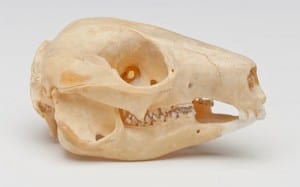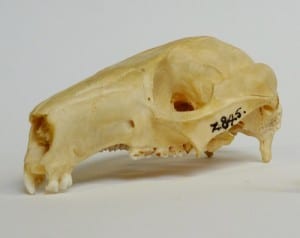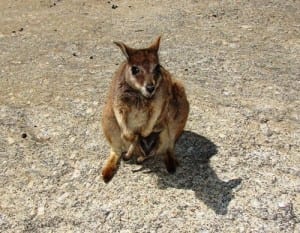Specimen of the Week 224: The Rock Wallaby Skull
By Jack Ashby, on 25 January 2016

Rock wallaby skull. LDUCZ-Z845
The high octane pop-rock band The B52s are responsible for one of the world’s most aggressive earworms – Rock Lobster. A tune so catchy that it takes no heed of the taxonomic boundaries in which it was placed. The B52s were very clear that the song’s habitat is a beach, and the lobster was discovered when somebody looked under a dock in 1978. Nevertheless, whenever I am on fieldwork in Australia, the unforgettable (no matter how hard I try) chorus begs to be applied to every rock-dwelling lifeform I encounter, none of which are crustaceans. In the sandstone escarpments of northwest Australia there are plenty of zoological opportunities for the song to crop up: rock ringtail; rock pigeon; rock rat; rock monitor; rock dtella; rockhole frog; but most of all, this week’s Specimen of the Week…
**Rock Wallaby**

Rock wallaby skull. LDUCZ-Z845
…aah aah aah aah. Rock wallaby. aah aah aah aah ROCK WALLABY [instrumental] Rock wallaby. Rock wallaby.
While I appreciate that this introduction is barely zoological, it may, perhaps, give some insight to what happens to the mind when tiny groups of ecologists are left isolated at a remote field site for weeks at a time in 47°C heat.
1. What’s a rock wallaby?
If you believe the scientific name, Petrogale, rock wallabies are actually rock weasels [Petro – rock; gale – weasel]. That’s really not very helpful though, as they do not resemble weasels in any way*. Rather, they are the marsupial versions of mountain goats, only bouncier. They belong to the same family as kangaroos – the Macropodidae – but they occupy rocky habitats: cliffs and boulder fields. They are a lot smaller than kangaroos (1-12kg, vs. a 60kg roo), but recognisably roo-shaped. Like goats, they are generalist browsing herbivores and are incredibly agile jumping around precarious precipices.
2. How do they do that?
My mum insists that jumping is not an activity that should be practiced on cliffs or boulder fields, but maybe that’s because I don’t have the appropriate anatomical adaptations. Rock wallabies have taken the famous kangaroo features – the feet and tail, and modified them. They have very short (for a kangaroo-relative) feet, so they fit on small surfaces, and they have very thick springy, granular pads which are very grippy. Unlike a kangaroo, they have highly reduced claws (to avoid a stilletos-on-a-cliff situation).
Their tail is much more flexible than their relatives, and is thinner and more tubular. This means they can use it as a counter balance and a rudder, allowing them to change direction sharply, as rock ledges are rarely in a straight line. Cheetahs have a very similar adaption for high speed chases.
3. Anything you can do, some marsupials can do at least as well
Most of the world’s mammals are placental mammals – they give birth to well developed young after a long period in the womb. Marsupial mammals do it differently – they have a short period of gestation and do most of their development on the teat suckling milk. Australia was only ever colonised by a few groups of land-living placentals – bats, rodents and more recently the dingo (as well as humans and their vermin). This means that Australian marsupials have evolved to occupy many of the diverse niches that placental mammals fill elsewhere.
Instead of deer, Australia has kangaroos. Instead of hyenas, Australia has devils. Instead of monkeys, Australia has tree kangaroos and possums. Instead of mongooses, Australia has quolls. Instead of weasels, Australia has dunnarts, antechinuses and mulgaras. Instead of moles, Australia has, well, marsupial moles.
Like I said, instead of mountain goats, Australia has rock wallabies. Although their bodies are not similar shapes, the niches are very similar – they are constrained by their evolutionary history and so have developed different solutions to deal with the same environmental challenges.
4. Bountiful and beautiful
There are over 70 ways of being a hopping marsupial. Kangaroos are the most famous. Bettongs are the cutest. Rock wallabies are the most successful (evolutionarily speaking). There are 17 species of rock wallaby, living across Australia. This is particularly impressive as these species have arisen from a common ancestor living only 4 million years ago – that’s a very rapid divergence. The 17 species are among the most strikingly adorned marsupials – many have very pretty markings on their faces and flanks, and one even has a bright yellow stripy tail.
5. A new species
The 17th of those species was only described a year ago, when it was realised that a reasonably common species – the short-eared rock wallaby – living across north and western Australia was in fact at least two species that were both genetically and morphologically different. The now-called western short-eared rock wallaby belongs in the Kimberley and western Northern Territory, while Wilkins rock wallaby hails from the northern and eastern NT. It’s relatively rare for new species of reasonably large mammal to be described. Such discoveries are particularly important as it can mean that healthy populations of what was thought to be a single species can suddenly become two seperate populations with half the number of individuals in.
It’s also good news for people like me, who has already seen short-eareds in both locailities, as it means I get to tick of a new species without even leaving my office. We call it an armchair tick.
* a number of marsupial scientic names include the weasel epithet. It is more appropriately applied to some of the small marsupial carnivores that at least scurry on four legs. The phascogales [pouched weasels] are even weasel-shaped, and the crack-dwelling planigales [flat weasels] are indeed flat.
References
Potter, Sally, Close, Robert L., Taggart, David A., Cooper, Steven J. B., and Eldridge, Mark D. B. (2014). Taxonomy of rock-wallabies, Petrogale (Marsupialia: Macropodidae). IV. Multifaceted study of the brachyotis group identifies additional taxa. Australian Journal of Zoology 62, 401–414. Available here
Van Dyck S, Strahan R, editors. The Mammals of Australia. 3rd ed. Sydney (Australia): Reed New Holland
Jack Ashby is Manager of the Grant Museum of Zoology
One Response to “Specimen of the Week 224: The Rock Wallaby Skull”
- 1
 Close
Close





[…] in the free world. Rock wallabies, nicely considered by Jack […]